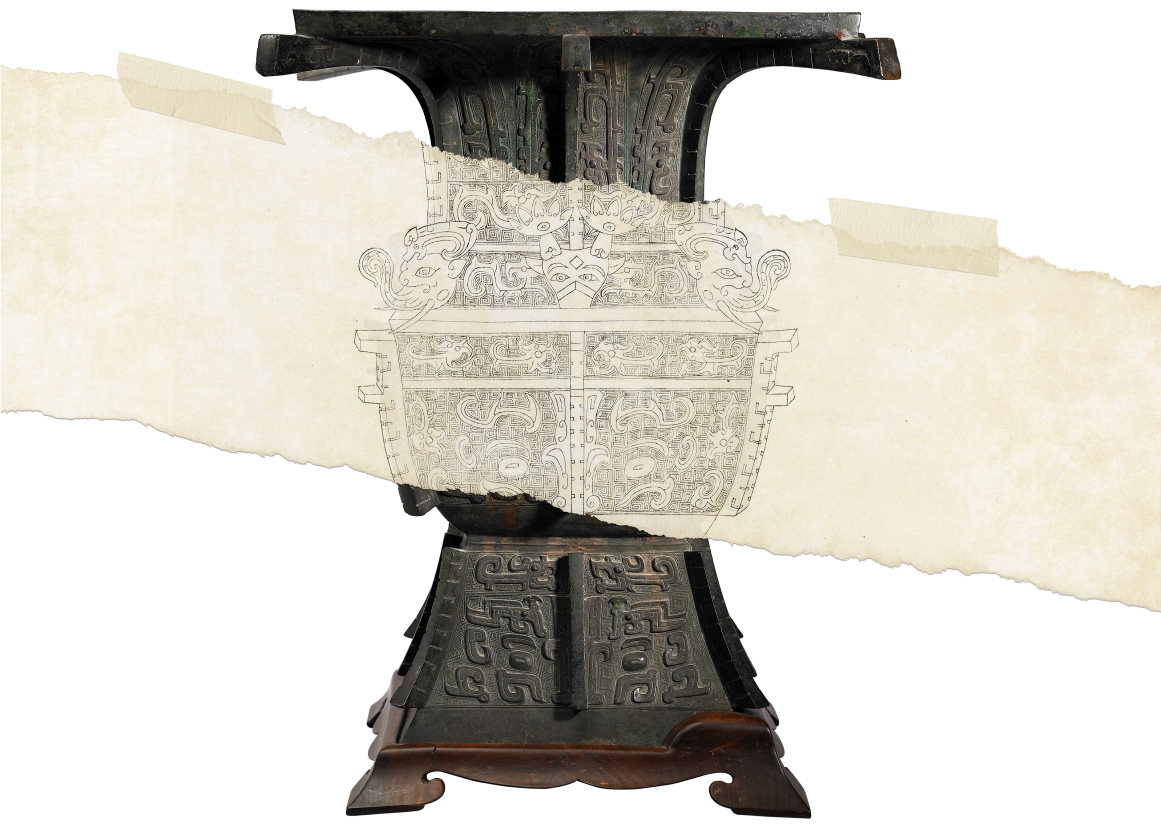Profound Reflections on Antiquities
Emperor Qianlong and Ancient Bronzes
Surrounded by ancient bronzes at the Qing court, Emperor Qianlong wrote poems on some of them, revealing his historical reflections and Confucian learning. In addition, Qianlong recruited officials to document the massive imperial collections of bronzes based on Emperor Huizong's Illustrated Catalogue of the Xuanhe Antiquities (Xuanhe bogutu, d. 1123), producing series of illustrated catalogues that were hand-painted and traced. These publications exhibit the variety of antiquities in the court collection, which dated from the Shang and the Zhou dynasties to the Han and the Tang dynasties, encompassing objects from the Central Plains as well as from foreign lands.
As the pacification of Muslim regions in the 24th year of the Qianlong reign (1759), the discovery of eleven ancient bronze bells in Jiangxi was regarded as an auspicious omen. After these bells were presented to the Qing court, Emperor Qianlong matched them for the traditional pitch-standards to think about the Xia, Shang and Zhou periods. Among the eleven bells, only four pieces survive today, including two displayed in this exhibition. The two bells were identical in shape and decoration. They were commissioned by Zhe Jian, a prince of the Wu state active in the late Spring and Autumn period, in order to pray for the ancestors with the melodious sound of bells.
All thirty-eight objects documented in the appendix of Xiqing Xujian Jiabian came from the west or southwest of the Qing Empire. Besides vessels, they also include weapons, musical instruments, seals and coins. Different from the traditional bronzes adorned with Chinese characters and decorative patterns, these objects represent cosmopolitan characteristics on the Qing borderlands. These foreign bronzes were included in the huge palace collection, been catalogued and researched, and became the cultural display of Emperor Qianlong's imperial martial achievements.
Drum with raised frogs
- Late Eastern Han to Six Dynasties, 2nd-6th century
- Documented in Xiqing Xujian Yibian (Second Supplement to Illustrated Catalogue of the Xiqing Antiquities), vol. 18, p. 1
Findings of bronze drums abound in the local gazetteers of the south during the Ming-Qing period. Emperor Qianlong also wrote a poem, "A Song of Bronze Drum", which recorded a "Zhuge drum" unearthed in Guangxi in the 8th year of the Yongzheng reign (1730). An essay in Xiqing Gujian (Illustrated Catalogue of the Xiqing Antiquities) relates bronze drums found in different locations to Ma Yuan's and Zhuge Liang's military conquests in Han dynasty. The matching of bronze artifact with historical legends reveals the then perception of bronze drums in the Qianlong period.
The first bronze catalogue compiled during the Qianlong reign, Xiqing Gujian (Illustrated Catalogue of the Xiqing Antiquities, 1755) consists of forty volumes and sixteen additional volumes on coins. As the imperial collection kept growing, the second catalogue Ningshou Jiangu (Illustrated Catalogue of the Ningshou Antiquities, c. 1781) in sixteen volumes catalogued bronzes housed in the renovated Palace of Tranquil Longevity. Two other supplemental catalogues were completed in 1793. Xiqing Xujian Jiabian (First Supplement to Illustrated Catalogue of the Xiqing Antiquities), composed of twenty volumes, recorded bronzes collected in the Forbidden City. Also in twenty volumes, Xiqing Xujian Yibian (Second Supplement to Illustrated Catalogue of the Xiqing Antiquities) listed bronzes kept in the Mukden Palace in Shenyang. Together, these catalogues documented a total of 4,105 objects and are the most comprehensive official catalogues of their kind, known as "the Four Catalogues of Xiqing" or "Qianlong's Four Catalogues."

Xiqing Gujian (Illustrated Catalogue of the Xiqing Antiquities)
- Edited by Liang Shizheng (1697-1763) and others
- The Wuying Palace woodblock-printed edition, 1755





